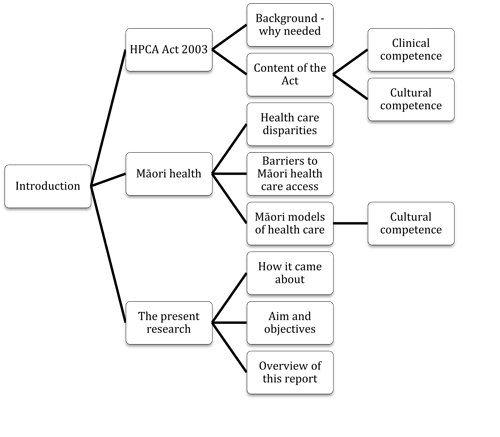In the last writer’s toolkit post I talked about using a Hollywood drama writing process to draft up an abstract for a report or proposal or any other piece of writing you may be tackling. The idea of getting an abstract, or short summary, written is to clarify what it is that you’ll be writing about. This will help you stay focused. This post is about turning that abstract into a table of contents that provides you with some structure to write to. Let’s first look at my abstract again.
The Health Practitioners Competence Assurance Act 2003 requires health practitioners to be both clinically and culturally competent, although it does not provide a clear definition of cultural competence. A question therefore remains about what fully competent healthcare looks like. A three-hour hui (meeting) with 10 Māori health practitioners provided a forum for the discussion of the links between their clinical and cultural competencies in their delivery of health care to patients and whānau (family). Whakawhanaungatanga (the process of establishing relationships) was pivotal to their health care practice models. The practitioners used terms coined by Mason Durie to describe patients’ journeys as beginning with engagement or whakapiri, where practitioners being Māori was most important for patients. In the next part of patients’ journey, cultural and clinical skills meshed to facilitate patients’ coping and sense of control over their journey and their healing; that is, whakamana. In the long-term practitioners worked with patients to facilitate their mana motuhake; their independence and inter-dependence. At every part of patients’ journey the practitioners built their relationship with patients, and facilitated patients’ ability to build relationships with their own whānau. It was concluded that clinical and cultural competency were not two separate skills; rather they intertwined with practitioners delivering clinical care within their Māori worldview to patients and whānau who engaged with them as Māori, and as whānau.
I want my research report to be fairly traditional; that is, it’ll contain an introduction, methods section, findings section, discussion and conclusions, and possibly recommendations. Then at the beginning it may have a 1-2 page executive summary.
In Microsoft Word there’s a SmartArt tool that I use to help me chart what’s going to be incuded in my Introduction, and then in other parts of my report. I like the SmartArt option that helps me construct a sideways tree of topcis and subtopics that I want to write about. If you don’t have Word or a computer application with something like SmartArt then pen and paper work just as well.

You’ll see from the tree I’ve constructed that I think my Introduction needs to cover two main topics in order to introduce my report adequately: the Health Practitioners Competency Assurance Act 2003, and Māori Health. The third topic, ‘The present research’, is about orienting readers to the research that’s going to be reported. I’ve then put in some sub-topics to be covered and, in a couple of instances, some sub-sub-topics. You can set this ‘tree’ or map out in a different format and go into even more sub-sub-sub-topics if this is useful to you. These topics and sub-topics can also be the headings and sub-headings in the Introduction inself.
I can then start writing about any one of these topics or sub-topics. It doesn’t really matter where I start because I now have a map of how topics and sub-topics are connected. This map also lets me use a writing procrastination trick: that if I don’t want to write about one topic (because of writer’s block, or just not being inclined), then I’ll write about another topic. This way even if I’m avoiding one piece of writing, I’m writing about something else that’s useful for my report. I know this is ‘real’ procrastination but it works for me.
There’s nothing in this process that says you can’t go back and revise your abstract if you realise you want to cover more things while you’re constructing a table of contents map. This is the same as revisiting and revising your table of contents map once you get writing and find that it doesn’t quite fit. Remember this mapping produces a writing structures that should be helpful for you in the work you want to achieve. If it’s not helpful then change it. (Just don’t mistake the structure’s helpfulness or otherwise with any issues of your own; for example, not being disciplined in your writing, or being too inclined to really procrastinate.)
In the next writer’s toolkit post I’ll talk about mapping out and writing your methodology and method (and what the difference is between the two). Kia ora.
Contributed by Fiona Cram
Writer’s Toolkit #1 – Writer’s Toolkit #2 – Writer’s Toolkit #3
Writer’s Toolkit #4
